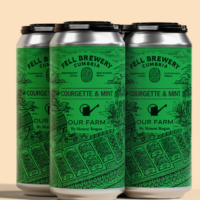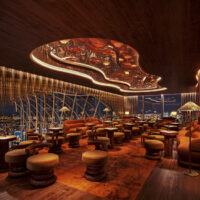After a spell in the proverbial wine desert Beaujolais Nouveau is having a minor revival and one that could have a positive role to play in the on-going rehabilitation of Beaujolais as a whole.
 It’s ironic, of course, seeing that it is generally agreed that it was Beaujolais Nouveau that helped trash Beaujolais’ reputation so thoroughly in the UK.
It’s ironic, of course, seeing that it is generally agreed that it was Beaujolais Nouveau that helped trash Beaujolais’ reputation so thoroughly in the UK.
Back in the 1980s and 1990s, Beaujolais Nouveau day (15 November) meant one wild party in Soho and the City, doorways festooned with violet balloons, massive over indulgence and purple vomit.
Such was the rate of consumption that many producers were geared towards it to such an extent they were barely making anything else.
So when the good times stopped rolling Beaujolais was caught short. The name was linked to one thing and that was, says Jean Bourjade, managing director of InterBeaujolais, wines that were a bit, well, “shit”.
Sales of nouveau took a turbo-powered nose-dive (except in Japan which remains the principal market for Beaujolais Nouveau) and buyers did not migrate towards the other wines the region had to offer: Beaujolais, Beaujolais-Villages and the crus. All Beaujolais was mud as far as buyers were concerned.
It has taken a very long time to painstakingly rebuild the region’s reputation with a concerted effort focusing on its AOCs and the remarkable efforts of some truly talented winemakers.
But rebuild the region has. Today Beaujolais holds a special place in the hearts of wine lovers and names such as Dutraive, Thillardon, Sunier and Foillard (and others) elicit approving noises whenever spotted on a wine list or a bottle is produced by a generous host.
Yet alongside the greater recognition that Beaujolais – and its principal grape Gamay – produce ‘serious’ wines there’s a persistent undercurrent that wants to remind everyone that Beaujolais is, above all, fun. And Beaujolais Nouveau sort of fits the bill.
Let’s be clear, no one would argue that it’s desirable for a return to the ‘old’ days of Beaujolais Nouveau or to undo the hard rehabilitative work and great strides the region has made.
Nonetheless, no other French region exudes quite as much bonhomie as Beaujolais nor has ever expressed it in a way quite like the release of ‘nouveau’.
Burgundy is a mite too monkish, Bordeaux too commercial, Champagne too glitzy, while the Loire and southern regions often have the requisite level of scruffiness but are somewhat too large to replicate the sense of camaraderie that appears so tangible in Beaujolais.
Beaujolais wines in general and nouveau in particular, due in part to their relative affordability while so many other fine French wines spiral upwards in price, encourage a guilt-free temptation to pull the cork on bottle after bottle.
It is fun, uncomplicated, unfussy, unpretentious and convivial.
It’s just so intrinsically linked to Beaujolais. As Adrien Dubeouf says: “All could have done it but only Beaujolais did and it suits Gamay and the region.”
This is perfectly true and it’s worth remembering that nouveau, while largely born of purely commercial interests, there are few grapes in France capable of making a drinkable wine so soon after harvest as Gamay.
From a historical perspective, this is more or less how all wines were once approached and enjoyed.
And on a deeper level, away from the marketing, it harks back to that joyous feeling of a harvest successfully gathered in, the prospect of new wine, a mood of celebration – elemental, communal feeling of the sort you wish you could bottle and for which wine is a substitute.
Used wisely the release of Beaujolais Nouveau and making a party of it is a way to throw the spotlight on all of Beaujolais.

Restaurants and wine bars are getting in on the act – Noble Rot for example – with Beaujolais Nouveau parties which, often as not, are a front for trying all Beaujolais not just the latest nouveau and that’s one way to keep the message broad and positive.
As Mathieu Mélinand of Domaine des Marrans, suggests: “November is Beaujolais time and not just nouveau – the new crus as well [meaning those crus released during the year].”
It’s also, suggests Duboeuf, a way of providing a “sneak peek” of the coming harvest –especially if it was a good one.
“We want to keep nouveau,” stresses Bourjade. “It’s a ‘happy day’. We want to give nouveau the attribute of a festive wine.
“No one said it was the best wine in the world. All the Beaujolais Nouveau we’ve lost was the rubbish, the poor quality. And it’s a good thing. The price was below the production cost so it’s good they’ve gone.
“What remains are small cuvée with individual stories and philosophy that break away from the industrial image of industrial wines that flood the world. They’re personalised and this is what interests consumers.”
This is a salient point and why a call for Beaujolais to not be afraid of fêting nouveau isn’t a call to commit mass commercial suicide.
Beaujolais Nouveau is being made in a way that is really quite delicious. In small batches – few quality-driven producers want to sacrifice juice better spent on AOC wines to produce nouveau – the results can be really appealing and while producers aren’t making lots they’re putting some time and care in to what they do make.
‘I think everyone is trying to make something nice and simple but with care,” continues Mélinand.
“It’s the first wine of the year so it’s a representation of your winery. I’m sure to make an effort to make something serious – though it’s not a ‘serious’ wine.”
Michele Chapel, who makes wine with her husband David at Domaine de la Chapel, adds: “Beaujolais Nouveau has become a monster over the years but what it is in spirit is very different”.
If that spirit can be harnessed and channelled in the right way, then it’s possible that arrival of Beaujolais Nouveau each November can still play into the wider celebration and appreciation of this brilliant region.




